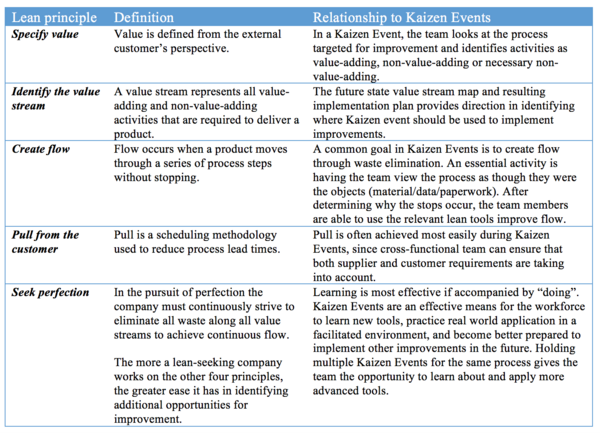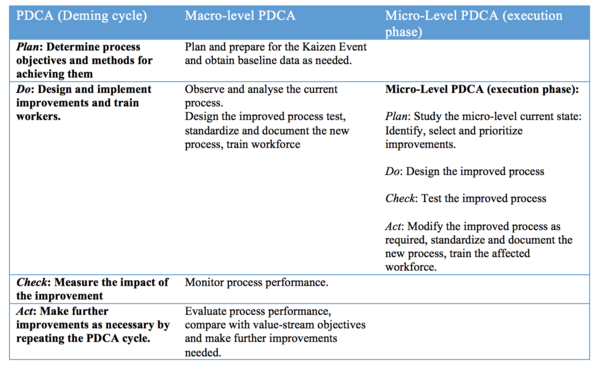Kaizen Event - a managerial tool for problem-solving
Contents |
Abstract
This article will look into how Kaizen Events can be used as a managerial tool for problem-solving processes for a project in an organization. It will thereby go into the category of Project Management. The article will introduce the term Kaizen Events relative to general lean principles and the Kaizen concept in Lean thinking. The article will then give an overview of how a Kaizen Event should be carried out and what important things to consider when doing so. The article concludes that Kaizen Events can be used as a bottom-up approach for rapid improvement and problem-solving beyond the context of lean manufacturing. It also states that a core benefit from carrying out Kaizen Events is creating motivation and problem-solving capabilities for the individual employees.
Keywords
Kaizen, Kaizen Event, Lean Thinking, problem-solving tool.
Introduction to Kaizen Events
Kaizen vs. Kaizen Events in Lean thinking:
Lean thinking a business strategy that revolves around removing or reducing waste and non-value-adding effort. Kaizen is however defined as a lean tool or method for achieving the 5 basic lean principles (Kaizen vs. Lean: Distinct but related, metalfinishing, January 2010). The article will elaborate on these principles in the section “Kaizen Events and Lean Principles”.
According to Lean thinking does the term Kaizen represent continuous incremental improvement, and it refers to a general way of thinking and behaving. Kaizen should be practised on a daily basis and it is about empowering and unleashing the creative power of people who actually do the work, in order to design more effective and efficient processes. This in order to spread lean thinking throughout the organization and teach the workforce how to effectively solve problems as they arise. Kaizen Events, on the other hand, are formalized activities that organization use to achieve rapid and dramatic improvements (Kaikadu) and progressively shift their culture. Kaizen events create a structured environment in which teams learn how to identify waste and apply specific lean tools to eliminate it. In this “learn-by-doing” environment, teams become more comfortable with their authority to make improvements. Under the guidance of a skilled facilitator, Kaizen Events generate rapid results, relying on the creative power of cross-functional team to design and implement innovative ways to perform work (Martin, K., Osterling, Mike, 2007, s. 21).
Kaizen definition
A Kaizen Event can be defined as: “A focused and structured improvement project, using a dedicated cross-functional team to improve a targeted work area, with specific goals, in an accelerated timeframe” (Farris et al., 2008, p. 1).
Kaizen Events are also referred to as Kaizen workshops or Kaizen Blitz or blitzen. Kaizen Events typically lasts a week, but the length can vary relative to the scope of the event (Jackson, Thomas L., 2013). This article will use the term Kaizen Events that defines a five-day event with the aim of rapid improvement. It especially goes into details with the frame of the Kaizen event as a problem-solving process in an organization.
Increasing use of Kaizen events
Kaizen Events are often associated with lean production and lean manufacturing (Womack et al., 1990), where Kaizen events can result in improvements in technical system outcomes, such as lead time, work-in-process inventory, and productivity. It has however also gained a reputation for providing social system outcomes, such as helping employees develop new problem-solving capabilities and increased motivation to participate in future improvement activities (Drickhamer, 2004a). Given this potential of Kaizen events for producing rapid improvement in both technical and social system outcomes, many organizations appear to be increasing their use of Kaizen events (Bane, 2002; Bodek, 2002; Melnyk et al., 1998; Oakeson, 1997). Kaizen events are an increasingly common organizational improvement mechanism aimed at work area transformation and employee development (Farris et al., 2008) and it is therefore also seen as managerial tool. This increased focus has also resulted in an expansion of the use of Kaizen events. Several companies has also started using the frame of the Kaizen Event as a problem-solving tool for concrete problems related to other areas in the company such as the R&D department focusing on product development.
Imai Masaaki and Kaizen as a problem-solving process
According to one of the formulators of the kaizen concept, Massaki Imai, is the problem-solving capability of the kaizen concept is one of its core elements:
”The starting point for improvement is to recognize the need. This comes from recognition of a problem. If no problem is recognized, there is no recognition of the need for improvement [..] Therefore, Kaizen emphasizes problem-awareness and provides clues for identifying problems” (Masaaki, Imai, 1986, p. 9).
Massaki claims that once a problem has been identified it must be solved and therefore does the concept of Kaizen also contain various problem-solving tools. Another core idea of the Kaizen concept is that all employees in the organization have the capability and the will to contribute to the continuous refinement and betterment of the existing activities (Styhre, A., 2001, p. 797). Instead of seeking to control and measure the activities of the employee, the managers should act as coaches, supporting the improvement activities carried out by the employees in the kaizen teams. This behaviour is facilitated in order to support a bottom-up approach where the individual employee has a say in the way problems are solved (Styhre, A., 2001, p. 801).
In his book “Kaizen - The Key to Japan’s Competitive Succes” from 1986 Massaki provides both analytical problem-solving tools based on attainable data, and more collaborative problem-solving tools based on verbal date. These methods are still valid and well-recognized. They are used frequently in Kaizen Event in companies around the world, but should be carefully selected relative to the scope of the Kaizen event.
Analytical problem-solving tools:
- Histograms: A visual way of presenting data.
- Control charts: Serve to detect abnormal trends with help from line graphs.
- Scatter diagram: Two pieces of corresponding data are plotted so the relationships can be compared.
- Graphs: Visual representation of data.
- Checksheets: These are designed to tabulate the results through routine checking of the situation.
- Pareto diagrams: Problems are diagrammed according to prioritu using a bar-graph format.
- Pareto charts can for example rank occurrences in the order of frequency.
- Cause-and-effect diagram: Characteristics of a process or a problem are analyze according to the factors that contribute to them. These diagrams are often referred to as “Fishbone” or Ishikawa (after its developer).
Collaborative problem-solving tools:
- Relation diagrams: Clarifies interrelations of a complex situation
- Affinity diagram: Essential in brain-storming method. Participant write down ideas and these ideas are grouped according to subject. Can also be used for organizing data from various media.
- Tree diagram: Interrelations of goals and measures.
- Matrix diagram: Used to deplaying quality requirements into counterpart characteristics.
- PDPC (process decision program chart): Decision program chart.
- Arrow diagram: PERT (program evaluation and review technique) and CPM (Critical path method.
Kaizen Events and lean principles
The five-step process for guiding the implementation of lean thinking in an organization is:
- 1. Specify value.
- 2. Identify the value stream.
- 3. Create flow.
- 4. Pull from customer.
- 5. Seek perfection.
The Kaizen concept belongs to the seek perfection lean-principle because the idea of achieving perfection is an on-going process that involves continuous improvements. In the Kaizen Events you however focus on all or one part of the other four lean principles (Martin, K., Osterling, Mike, 2007, p 5). The relationship between the 5 lean principles and Kaizen events is explained in table 2.
Overview of Kaizen Event
General activities for a Kaizen Event
Most Kaizen events are conducted using a three- to five-day concentrated work session with typical activities including (Melnyk et al., 1998).:
- Team training
- Documentation of the current state
- Identification of opportunities for improvement
- Improvement selection (and often implementation);
- Results presentation
- Documentation of an action item list for follow-up activities
The full Kaizen Event process also includes activities occurring before the actual event, including event selection, scoping, and planning, as well as activities occurring after the formal event concludes, including follow-up actions to sustain changes and improvements. Further, activities representing the planning of the Kaizen event needed such as facilitator selection and training, development of standard event training materials, and communication mechanisms to document and distribute improvements and results.
In general, Kaizen events use general lean principle tools such as quality circles and continuous process improvement teams: identifying low-cost improvements through the application of process analysis and problem-solving tools. Both “traditional” lean tools, such as process flowcharts, cause-and-effect diagrams, and Pareto charts, and lean production tools, such as standardwork, 5S, and single-minute exchange of die. In general does these improvement mechanisms stress the key role of employee involvement, incremental improvement, and organizational culture change in driving and sustaining performance improvement (Laraia et al., 1999; Melnyk et al., 1998; Sheridan, 1997; Imai, 1986; Dean and Bowen, 1994; Hackman and Wageman, 1995; Kaye and Anderson, 1999).
PDCA and Kaizen Events
Kaizen Events use the scientific approach of plan-do-check-act (PDCA), one of the cornerstones of the Toyota Production System. The PDCA improvement cycle focus on seeking perfection rather than waiting for perfection. The PDCA cycle is present at two levels Kaizen Events. The three phases of Kaizen Events – planning, execution and follow-up (macro-level). During the Event itself (the execution phase) lies a micro PDCA cycle (Martin, K., Osterling, Mike, 2007 p. 23).

